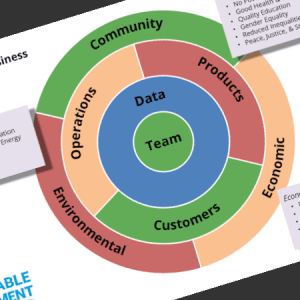If you are looking for a simple place to start your Digital Transformation, try to focus on how your teams understand the Why and the How of what you do every day. Sounds simple, but it will be immediately impactful - and a great first step on your journey.
I have been writing a lot lately about Digital Business and Digital Transformation … but do these strategic Digital ideas apply equally to all organizations? Is there really a transformational opportunity for every business out there, if they just embrace their place in a Digital world?
Clearly they are some organizations where a Digital Transformation should be a straightforward exercise. For businesses that trade in easily digitized products – publishing, consulting services, or software, for example – what is standing in their way? They have a few puzzle pieces already covered; the product is information-based, and their customer-facing processes are already automated. Some components of Digital thinking are already built-in to how they do what they do – it should be a much easier transition for these companies than, say, a old-fashioned industrial manufacturer, shipping out pumps or valves or big machines, stamped or cast out of metal and driven by motors that convert energy into physical action.
It seems logical that a “born Digital” business might be better suited to a full Digital Transformation, while the “traditional” organization would struggle. However, things are not always what they seem. There are multiple components to a Digital Business – and we should not see any one of them as more critical to success than the others. A manufacturing firm may have a completely manual process for connecting with their customers (faxed or phoned-in orders? No problem …). On the other hand, we often find that same manufacturer delivering high levels of customer satisfaction with on-time and accurate deliveries, while at the same time keeping inventories low and cash flow high. Such a firm is reliant on well-run systems to automate and optimize their planning – a highly Digital place to be.
As for your technology partners that traffic in Digital products and services … well, how many times have you had to struggle with that boutique consulting firm with a chronic inability to mail invoices on time, where lots of manual processing is required to get the bill right. Another example where the cobbler’s children have no shoes!
Few organizations can truly claim to be “born Digital”- but there are simple ways to tell if your firm may have a leg up on the process. Just look at how your teams already think about the value of facts – and the value of people.
- Data: You may not have a terrific accounting system for internal processes, sophisticated customer-facing systems, or digitally enabled products – but how do you think about identifying opportunities to grow revenue? And how do you think about identifying and truly understanding operational problems and how to best address them? Do your teams come to the table with hard numbers (where possible) and specific examples (at a minimum)? If your teams work to target and realize opportunities and solve problems by “speaking in facts” (not opinions), you are in a great spot. Your business is nicely predisposed to understanding the value of data – you just need systems and processes to crunch the data you have, and collect the data you are missing.
- Teams: Regardless of the product, processes, and customers – does your organization value the people on your team? Do you seek to build a diverse team, that communicates openly in an environment of trust, where good ideas matter? Do you clearly communicate the mission of the team? Do your managers work to understand how to get the best out of your people? Do you treat people with respect – not coddling them, taking care of their every whim, but by acting with a clear intent and focus on why the business exists in the first place? When your organization pays attention to the people that work there, you are in excellent position for a Digital Transformation.
Some might argue that the focus on your team, and how they work together in support of the mission of the company, your customers, and the value you deliver with your products, is the most important component of a Digital Business. It certainly is the most important component of a successful Digital Transformation – any level of change impacts people, and requires those people to make that change happen.
In fact – if you’re looking for a simple place to start, before you launch into a holistic Digital Transformation, would be to focus on how your teams understand the Why and the How of what you do every day. Sounds simple, but it will be immediately impactful – and a great first step on your journey.
17 February, 2019






Comments (5)
James,
interesting idea, have you considered how difficult the digital transformation is? A couple examples.
Music is digital and was reproduced on multiple different devices, yet the only thing keeping record companies in business is their back catalogue. Spotify, etc is the future of music, Universal, Warner etc. are almost insignificant.
Movies are digital and dominated for 100 year, but with the possible exception of Disney, the rest are irrelevant. The future belongs to Netflix and Amazon.
Newspapers should be easy to transfer, they sell narratives, however, newspapers are remnants, only relevant because of prior glory. The 3 newspapers that may survive are The WSJ – owned, redirected and funded by Murdoch. They NYT, underwritten by a robber barron, Carlos Slim. And the WashPo, purchased and redirected by Bezos.
Even when companies see the future, e.g. Kodak, IBM, Sun etc. they are almost hopeless in their attempts to transform.
I think that even through individuals can see and fully grasp what is happening, is tremendously difficult for an organization structured in one paradigm to change to another. I just can’t think of many examples where company’s have transformed.
Ha, what a great question – can I come up with some examples? Hmmm, a tough one …
Thankfully, Google to the rescue … found these examples … here and here
In the industrial world, I know of many smaller businesses that have taken on some significant change in introducing new and different thinking – maybe not as a complete Digital Transformation, but some pretty interesting rethinking of their products … including our own Fire & Safety business, connecting rescue vehicles to the internet!
James,
sorry for the late response to these comments, I don’t get notifications of comments and only thought to look back to this when your post on “Transport-On the Road” came through.
The examples are interesting, though, to me, they reinforce my point about how difficult transformation is. Of the 14 examples cited between the two sources, there’s only one that seems to have transformed, Dominos. They are an extraordinary story, though to be honest, I think I’ve had their pizza once in the last 20 years and that was ordered by people at work. Most of the others are obscure to me, so I can’t comment intelligently, with the exception of the NYTimes. To me, they’re surviving, I’m not sure that I’d call them a success.
Which emphasizes my point, it’s incredibly difficult. You’ve probably already read it, but Andrew McAfee and Erik Brynjolfsson’s “Machine Platform Crowd” makes an excellent point that people in 19th century companies all saw the benefits of electricity, they all installed it, but almost none of them managed to survive the change from water powered factories to electrical factories. I believe it is going to be similarly rare to see companies survive the change from analog to digital platforms. For example, it is immensely more difficult to migrate mainframes and data centers to cloud computing micro-services than it is to rewrite the computing platform from scratch.
It is a very difficult path.
Andy
Hey Andy – I appreciate your comments – and thanks for pointing out a shortcoming on my site. I have now added the ability to subscribe to comments and replies!
Isn’t “digital” fun!
James,
thanks, I got the notification, process improvements do work.
FWIW, looking at the problems of migrating on-prem/mainframe systems to cloud micro-services is the reason I left Kohl’s and joined a StartUp. Writing capabilities from scratch is much easier than dealing with legacy applications. And if we get a good Series B round, the world will look very different.
Individuals have advantages over companies,
Andy